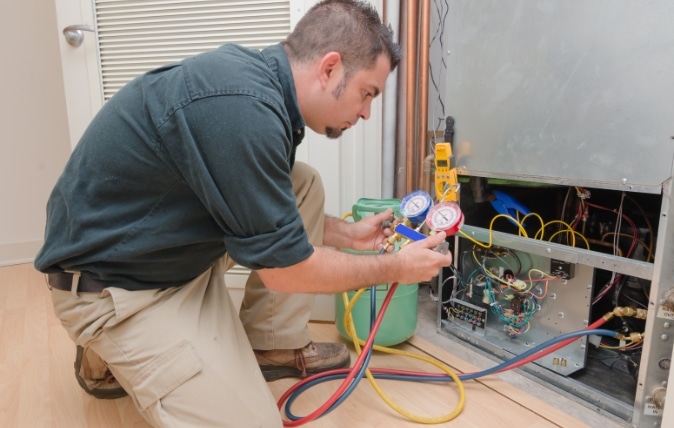
The Steps Taken To Fix An HVAC Refrigerant Leak
Refrigerant leaks in HVAC systems are more than just an inconvenience; they can lead to reduced efficiency, increased energy bills, and potential environmental harm. If you suspect a refrigerant leak, it’s crucial to address the issue promptly to avoid further complications.
The heating and cooling comfort experts at Hydes will walk you through our expert team's steps to identify and fix refrigerant leaks. From initial detection to thorough repair, we will provide you with all the information you need to understand what can be a quite complicated service.
How A Refrigerant Leak Service Works
The leak repair process in an HVAC system involves several meticulous steps to ensure the issue is fully resolved.
- Our HVAC technicians perform leak verification to confirm that there is an actual refrigerant leak and it is not another issue with your air conditioner.
- The next step is locating the exact source of the leak, which can be challenging but is crucial for effective repair.
- Depending on the severity and location of the leak, the repair may involve sealing the leak or replacing the affected components entirely. In cases where specific components are severely damaged or worn out, individual component replacement might be necessary to restore the system's functionality.
- Finally, our team conducts thorough final checks to ensure the repair is successful and the system is operating efficiently.
Locating the Refrigerant Leak
The HVAC technicians at Hydes may use up to four different leak inspection procedures to find the refrigerant leak. With each inspection procedure, we take a progressively deeper dive into finding the leak. The different methods are as follows:
Leak Search #1
Our initial leak inspection process begins with a comprehensive visual inspection of the HVAC system. Our technicians carefully examine all accessible fittings, looking for any obvious signs of leakage or damage. We use a specialized leak detector solution on all accessible fittings. This solution helps us pinpoint the exact location of the leak by identifying areas where refrigerant may be escaping.
- During this initial phase, we do not disassemble any equipment; instead, we inspect the system in its "as is" condition.
- This approach allows us to quickly and effectively determine the presence and location of any leaks without disrupting the overall integrity of your HVAC system.
Leak Search #2
If the leak is not identified in the previous service, our next step involves a more detailed examination that involves disassembling the evaporator coil and/or condenser. This allows us to access and inspect areas that were not visible during the initial check. Our technicians conduct a visual inspection and utilize electronic refrigerant sniffers and ultrasonic test equipment to help pinpoint the location of the leak.
- It's essential to have a reasonable amount of refrigerant and pressure in the system during this test to ensure its success.
Leak Search #3
When the refrigerant leak has still not been located, our next service not only involves disassembling the evaporator coil and/or the condenser, it also calls for pressuring the system. Nitrogen is introduced into the system to create the necessary pressure that helps make the leak more visible. Our technicians will then perform a meticulous visual inspection and employ advanced leak detector equipment.
- If any measurable amount of refrigerant is found in the system before pressurization, it will be pumped into the compressor and sealed off beforehand.
- This step prevents the refrigerant from mixing with the nitrogen, thereby minimizing the cost associated with adding new refrigerant.
- Leaks at the condensing unit will be identified through a process of elimination.
Leak Search #4
Our final leak detection method involves complete system isolation, a thorough process that may take 2-3 days. This method involves separating various components of the refrigeration system and pressurizing each component individually. By isolating and testing each part separately, our technicians can pinpoint the exact source of the leak with precision. This meticulous approach ensures that even the most hidden or complex leaks are detected and addressed. Although it requires more time, complete system isolation guarantees a comprehensive and reliable solution.
- As in Leak Search 3, before pressurization, if any measurable refrigerant is found, it will be pumped into the compressor and sealed off.
- This prevents any mixing with nitrogen, minimizing the cost of adding new refrigerant.
- Leaks at the condensing unit will be identified through elimination.
Resolution Of The Refrigerant Leak
Fixing a refrigerant leak typically falls into two categories: repairing the leak or replacing the faulty component. In some cases, a complete system replacement may be the best option.
- Repair Accessible Refrigerant Leak: Our technicians will repair the leak by tightening connections or sealing and brazing the leak area.
- Replacement of Faulty Refrigerant Component: Non-repairable components will need to be replaced. Common faulty components include the evaporator coil (80-85% leak rate), the condensing coil (10-15% leak rate), or the refrigerant lines (1-3% leak rate). These percentages can vary based on factors such as the system's age, installation quality, and maintenance practices.
Final Checks
After repairing a refrigerant leak, our technicians conduct thorough final checks to ensure the system is fully restored and operating efficiently.
- Verify that the refrigerant leak has been fixed, ensuring there are no remaining issues.
- Vacuum and evacuate the system to remove any air or moisture, which can affect performance.
- Verify that the refrigerant levels are in accordance with the manufacturer's specifications.
- Check the overall system performance to ensure it is operating as per the manufacturer's standards.
A Refrigerant Service You Can Trust
Our comprehensive leak detection and repair process ensures that every potential issue is identified and resolved, from initial inspections to final checks. By understanding how the leak detection, repair and final inspection all work, you'll feel confident when an HVAC technician provides you with his or her report.
To learn more, or to schedule your refrigerant service with Hydes, connect with our team today at (760) 360-2202 !














